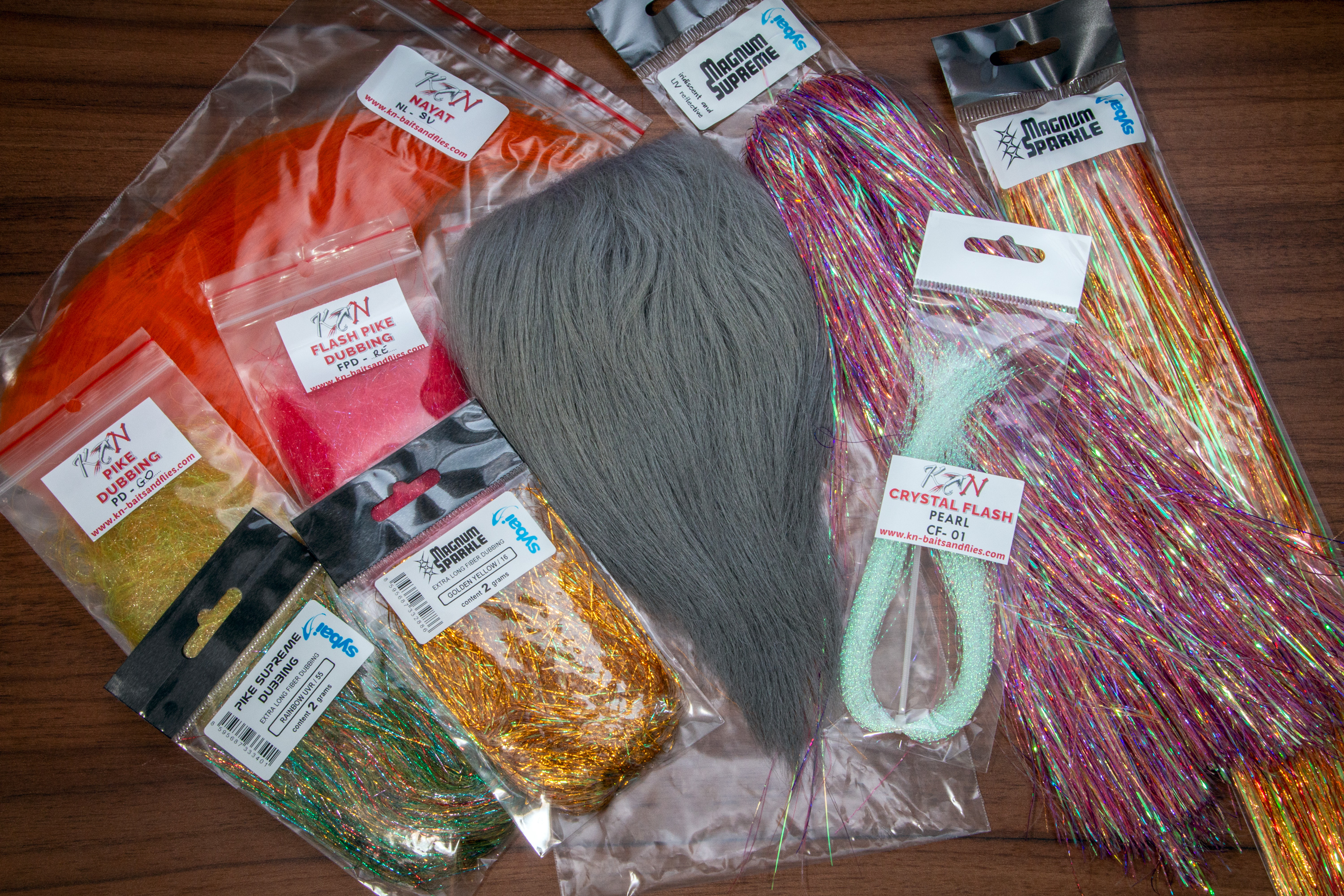Pike fly tying materials

Pike flies are mostly large patterns of flies tied on hooks, but also on larger, thicker tubes. Due to their above-standard size, these lures are most often 15-18 cm long, and there are also larger, much larger pike streamers up to 25 cm long. There are even larger ones made on two hooks connected together – tandem flies. They are made for the spinning method and are most often used with a Cheburashka sinker.
In large patterns, the use of natural fly tying materials, is limited, as they absorb more water and increase their weight compared to synthetic materials. For fly anglers, the weight of the fly is very important, but anglers using a spinning rod have no problems with it.
What fly tying materials? Synthetics, natural fur and what else?
Synthetic fly tying products are available in most online fishing stores. First of all, they have an extremely important advantage - they do not absorb water and after removing the fly from the water, during the first casts the fly dries quickly and loses its weight.
This makes it much easier to cast the fly rod smoothly over longer distances. Unfortunately, most natural materials do not have this feature, but more on that later in the text.
Flash materials for large pike flies are essential synthetics for tying big flies, which are worth having and a must have. Pike often like it when the bait shines. When it comes to flashes, it is worth buying something long so that you can use it for the largest patterns. The basics are various types of flashabou, crystal flash in magnum versions, or mixtures of these and other shiny materials. Ordinary standard flesh are unlikely to be suitable, the pike's teeth will quickly cope with them.

Pike streamers often have heads made of long synthetic materials, or more precisely, long fiber dubbings. Thanks to them, we can finish the fly nicely and give it a better shape, make the back or belly of a different color, and simply have more color options for different conditions in the water. Synthetic pike dubbings with long and thicker fiber are a great material for the heads of large fishing flies. You can use them to tie one or two colored heads, as well as a streamer tails.

However, as everywhere, there are exceptions, and this is the hair of the nayat - snow runner, which is currently the top material for large pike flies. This hair is long enough, it is not as soft and delicate as the hair of Icelandic sheep, and most importantly, a fly tied from it removes water very well during the first casts. It works great in water, so you can use it to make long tails or heads tied in reverse style from shorter hair.

Apart from the classic hair that is available on the skin, a great option is a dubbing brush made of nayat hair, which is nothing else than a chenille made of nayat. It allows you to tie the fly faster and distribute the material more evenly on the body.

It is also worth having bucktail hair as part of the set, but at the moment when I am writing this text, they are harder to find in the USA and their prices have gone up significantly. Another industry is to blame for this, let's say fashion ;) , which buys most of the production.
Large eyes for flies are essential, without them the bait loses its soul. They need to be large, 8mm is the minimum and 10mm is a standard size. Here it is worth paying attention to Fluo eyes, which can make a difference. In recent years they have become very popular among Scandinavian fly anglers.

Feathers are not a material often used in large flies, hackles are not made, but you can use long saddle feathers to finish the fly. Such feathers are most often attached after tying the body of the fly and enrich its sides, where, for example grizzly feathers look amazing. If such a feather is dyed in a fluorescent color, in many cases the fly will more effectively tempt pike to attack.
Which fly tying thread should you choose for large flies?

Threads must be strong, so anything that is thicker and allows you to pull the materials to the hook shank is a very good choice. Most brands producing threads have such strong versions, maybe apart from Czech brands ;).
Personally, for me the best product of this type is the G.S.P. thread with a thickness between 100 and 200 Denier. Extremely strong and no classic thread can compare to it. I have been using it for years and for me the GSP thread is the Big Fly thread - I certainly wouldn't change it to anything else.
Which fly hooks to choose for large pike flies?
Here we have a thick caliber and the most frequently chosen hooks are size no. 5/0, but fans of extreme pike fly fishing for the biggest predators reach for even larger models of fly hooks.

If you don't have very strong equipment for casting of larger flies, you can easily go down to a 3/0 or even 1/0 hook. Make something smaller and we'll easily catch something toothy.
The problem with casting large spinning flies does not concern lure fishing fans, because in their case it is enough to choose the right weight of the cheburashka (but not too heavy so that everything continues to work in the water) and that's all.
Personally, I use sizes from 1/0 to 5/0 for pike streamers. Why? There are simply days when the pike in the waters in my area do not want a very large fly. This is when patterns of about 10-12 cm on a smaller hook show that there are fish in that water and you can catch something there.
Besides, my pike killer fly (photo below) is a fly on hook no. 1/0, and best of all, large perch also like it.

Hooks are not everything, as large flies for pike can also be made on thick plastic tubes. They are similar to those used on salmon flies, however they are larger in diameter.
Pacchiarini tails - brilliant for the biggest streamers

We can finish large and largest patterns with a very interesting material that is used not only for flies for pike, but also for large saltwater species. The tails were designed by the great Italian fly fisherman Paolo Pacchiarini, a specimen hunter, and most importantly, they are made of brilliant material. It is very durable and holds together even when damaged by the sharp teeth of a pike.
Avoid tails made of rubber or silicone materials, as the pike will quickly bite them off or seriously damage them.
It is worth remembering that to properly and far casting of large streamers, we need strong equipment in the AFTM 10 class, so this is not an exaggeration. Therefore, many fly anglers with lighter equipment in the 7-8 class use hooks in the 1/0 to 3/0 range and slightly smaller patterns or with less materials.
best regards
Krystian Niemy
Recommended

3D Epoxy Eyes 9mm - Fluo Red

Sybai Magnum Sparkle

Fly Hooks KN Fly Strong Pike HF655

